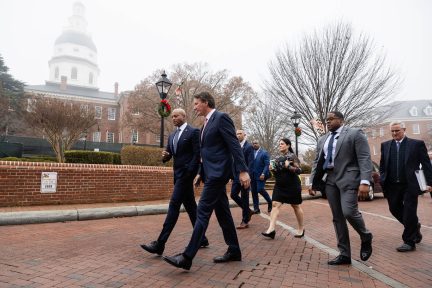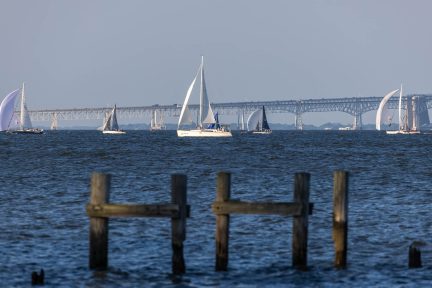Chesapeake Bay Program funding helps four local communities in designing beneficial green infrastructure projects
Pilot program works with historically excluded cities in designing projects to improve the environment and support quality of life
The Chesapeake Bay Program is pleased to announce that four communities throughout the Chesapeake Bay watershed have been given tools to meet their environmental and community needs. Launched in 2021, the Targeted Outreach for Green Infrastructure pilot program, sought to work with underserved regions in using green infrastructure to manage stormwater, improve water quality, add habitat and provide community benefits such as open space, pedestrian safety, shade and beautification. The designs for these four pilot projects are now complete.
Funded in 2020 through a U.S. Environmental Protection Agency (EPA) grant, administrated through the Chesapeake Bay Trust, allowed Chesapeake Bay Program partners, led by the U.S. Fish and Wildlife Service (USFWS), EPA and Chesapeake Research Consortium, to work with four selected communities to design green infrastructure projects that would improve the region’s quality of life, increase climate resilience and support priority habitat for fish and wildlife.
Green infrastructure uses natural features such as rain gardens, wetlands and bioswales, as well as techniques to redirect, capture and store rainwater for uses in items like rain barrels and cisterns, to mitigate flooding, sewer overflows and water pollution. Green infrastructure installations have been proven to improve public health, create wildlife habitat and reduce stormwater runoff and its associated pollution.
Communities were selected based on the following: must be above the 50th percentile nationally for low-income population, considered to be at risk for either sea level rise or climate change-driven flooding, at least 20% of population consists of minorities and is adjacent to an area with a high habitat value (defined as having particular biological, ecological, social or cultural significance). After considering this criteria, Cambridge, Maryland, Williamsport, Pennsylvania, the Virginia-recognized Mattaponi Tribe and the federally-recognized Upper Mattaponi Tribe were chosen as partners.
“Climate change is transforming lands and waters that people and wildlife depend upon, with disproportionate impacts on communities that are most vulnerable,” said Chris Guy, coordinator, Chesapeake Bay Program Habitat Goal Implementation Team and USFWS liaison to the Chesapeake Bay Program. “Partnering with communities to address these complex issues is essential—successful partnerships start by bringing people together early to talk about their needs and concerns, and continuing that dialogue throughout the process.”
A steering committee consisting of local, state and federal government staff, Tribal representatives, and representatives from regional and local environmental and community organizations worked with Chesapeake Bay Program staff to conduct community listening sessions to identify local opportunities where climate change-related problems could be addressed through green infrastructure, while helping to meet local needs. Listening session participants were then invited to participate in a green infrastructure design workshop, tailored for each community to review preliminary design concepts and provide feedback.
This process resulted in the following community-driven, green infrastructure design proposals:
- Cambridge, Maryland: Create a community park that meets local needs for gathering, gardening and recreation, while enhancing natural beauty, water quality and ecological function through wetland restoration, bioretention structures, habitat gardens and other features.
- Mattaponi Tribe (Virginia): Stabilize the riverbank of the Mattaponi River to address erosion and provide habitat, particularly to support species of importance to the Mattaponi Tribe, such as American shad.
- Upper Mattaponi Tribe (Virginia): Sustainable development on a historical Tribal property that would offer a community gathering space, housing and recreational opportunities, as well as create access to the Mattaponi River and other recreational amenities.
- Williamsport, Pennsylvania: Expand an existing community garden and green space on vacant lots owned by the University of Pittsburgh Medical Center for use by hospital patients and community members, and enhancing the streetscape along Little League Boulevard for beautification, public safety and improved connectivity to the downtown.
Specific project details for each location can be found at https://d18lev1ok5leia.cloudfront.net/chesapeakebay/TOGI-Final-Report.pdf.
Maryland
“It was a blessing when I was given the opportunity to engage with TOGI [Targeted Outreach for Green Infrastructure] to try and figure out how we can deal with both of our struggles,” said Lejan Cephas, president commissioner for the City of Cambridge. “This design will engage with our residents who live in more underserved regions of the city, address increases in crime and help us properly manage our stormwater.”
Members of the Cambridge steering committee included representatives from the city planning department, Alpha Genesis CDC, ShoreRivers, Maryland Department of Natural Resources, as well as interested residents. A cooperative agreement is now in place with the National Park Service Chesapeake Gateways Networks and the City of Cambridge to fund the site plan design in a phased approach.
Pennsylvania
“This proposal would address an approximately two-mile stretch of Little League Boulevard that is not amenable to pedestrian traffic,” Mel Zimmerman, director of the Clean Water Institute at Lycoming College. “By installing better crosswalks, bike lanes, greening through street trees and better stormwater infrastructure, it will be easier for residents to travel from one part of Williamsport to the other either by foot or on bikes.”
Members of the Williamsport steering committee included representations from the Northcentral Pennsylvania Conservancy, University of Pittsburgh Medical Center, Lycoming County Government, Pennsylvania Department of Conservation and Natural Resources, Salvation Army Community Garden, Responsible Drilling Alliance, Pennsylvania Department of Environmental Protection, Heart of Williamsport and Lycoming College Clean Water Institute.
The scope of the Targeting Outreach for Green Infrastructure project did not include funding for implementing the designs, but the steering committee is assisting communities in identifying funding opportunities. In Williamsport, a donation from the University of Pennsylvania Medical Center Field Office is expanding the community garden at the medical center and partnering with the USFWS Pennsylvania Field Office to ensure it contains ample pollinator habitat.
Zimmer continues, “Williamsport is the ideal size for this project. We are three hours from everywhere, so we don’t receive a lot of outside investment. The community engagement for this project has been well-received and our next steps are to use the initiatives developed by our steering committee to follow through on these green infrastructure proposals.”
Virginia
“The Upper Mattaponi and many other tribes in this region consider themselves to be water people, so it’s important to us to return the majority of the area back to the natural habitat it was and ensure tribal citizens have access to these areas,” said Leigh Mitchell, the environmental and cultural director for the Upper Mattaponi Tribe. “TOGI [Targeted Outreach for Green Infrastructure] has really been a resource to help the tribe build capacity for these projects.”
Members of the Upper Mattaponi steering committee included representatives from the tribe, Virginia Department of Conservation and Recreation’s Shoreline Erosion Advisory Service, Virginia Coastal Policy Center at the William & Mary Law School, National Oceanic and Atmospheric Administration and the U.S. Geological Survey.
“The cultural traditions and identity of the Upper Mattaponi Tribe revolve around these sacred waters and the resources found within them,” continued Mitchell. “With the help of TOGI, this is the first opportunity we’ve had to access our namesake river since colonization over 400 years ago.



